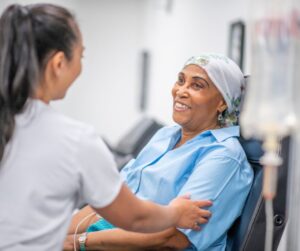Bo Gamble
Payers of all types have increased their focus on quality and value over the past 10 years. This is particularly true with Medicare, including the Merit-Based Incentive Payment System (MIPS); COME Home, the community oncology medical home model; the Oncology Care Model; the upcoming Enhancing Oncology Model; and an oncology MIPS Value Pathway. Commercial insurance companies have followed, with many different initiatives. But what about the patient? Where are they in these campaigns?
Family members, friends, and patients often reply “Great!”, “Awesome!”, or “Tip-top” when asked how they are doing. But are they really? There are many reasons why their answers are not honest or more transparent. One reason could be a reluctance to unload a problem on someone who has no solution. Some patients may suffer from a fear that the clinician may start or stop treatments based on new symptoms, and they disclose as little as possible so they can escape quickly. These patients often withhold information from their care team.
Reforming the health care delivery system requires new thought processes and perspectives. This is particularly true for patients. Knowledge builds trust and trust builds knowledge. The more we know about our patients, the more they will trust us—and vice versa. Said another way, patients want to know how much we care before they care how much we know. Conveying this care, while also seeking honest patient information and feedback, requires focus and sensitivity. This feedback is gathered in several ways.
Experience feedback—Also known as patient satisfaction surveys, these instruments measure wait time, timely communications, thoroughness, friendliness, respect, etc. Used properly, this feedback is scored, shared with the entire care team, and used to modify processes and procedures to improve weak areas. New surveys help determine the effectiveness of the changes. The use of patient satisfaction surveys is the most common process to gather objective patient feedback.
Patient-reported outcomes (PROs)—PROs can take different forms: electronic (ePROs) or as measures (PROMs). These questions and measures are patient specific and related to their current health status. The Patient-Reported Outcomes Measures Information System (PROMIS), developed and funded by the National Institutes of Health, is a set of person-centered measures that evaluates and monitors physical, mental, and social health in adults and children. It can be used with the general population and with individuals living with chronic conditions. PROMIS hosts more than 300 measures for adults, covering a wide range of health issues: sleep, anxiety, speech, and swallowing, to name a few. Pain, fatigue, and quality of life are relevant to cancer care, and the measure count is 34, 17, and 74, respectively.1 The implementation of PROMs has added a layer of responsibility and accountability to the care process, especially after the completion of a cancer treatment journey. For example, suppose a patient reports intense pain or fatigue 90 days after treatment is completed and the patient has received survivorship planning. This could be new information that demands unscheduled intervention.
Social determinants of health (SDOH)—These are also known as health-related social needs. The World Health Organization and the U.S. Department of Health and Human Services define SDOH as the conditions in which people are born, grow, work, live, and age, and the wider set of forces and systems shaping the conditions of daily life.2 The emphasis on SDOH places added responsibility on the cancer care team. In addition to focusing on the tumor, care teams are being asked to look beyond the walls of their building. Is the patient living in a food desert? Are they sleeping in a car? Do they have transportation to and from the office for their scheduled appointment? Asking these questions is the easy part. What is your plan when the patient doesn’t have food, shelter, or transportation? There are tools that can assist with resources (for example, www.findhelp.org), but staff, time, and processes are needed to ensure key questions are asked and meaningful intervention is offered. Successful attention to social determinants requires a caring and trusting environment.
Health equity—The word “equal” suggests uniformity and consistency. Cancer care teams may assume they are being fair and consistent with all of their patients; however, equality is judged by the recipient of the care. Do male and female patients perceive quality of care the same way? What about a 30-year-old patient with cancer compared with a 70-year-old patient with cancer? The differences can be even more pronounced when patients’ socioeconomic status, racial or ethnic backgrounds, and educational levels are taken into account.
Addressing patients’ needs and perceptions can only happen when questions are asked—questions that are sincere, non-threatening, and have some degree of specificity. The answers may be provided in detailed explanations or quantified using credible tools and technologies. Trust is built when the findings are met with meaningful responses provided in an efficient and effective manner. Advanced practice providers have become important members of the cancer care team. Their sensitivity to the patient and their personal communication skills, combined with those of practice leaders, help to deliver the best care throughout the patient’s cancer journey while also ensuring that obstacles and issues to that care are minimized.

References
- Health Measures. Transforming How Health Is Measured. https://www.healthmeasures.net/
- World Health Organization. Social Determinants of Health. https://www.who.int/teams/social-determinants-of-health







